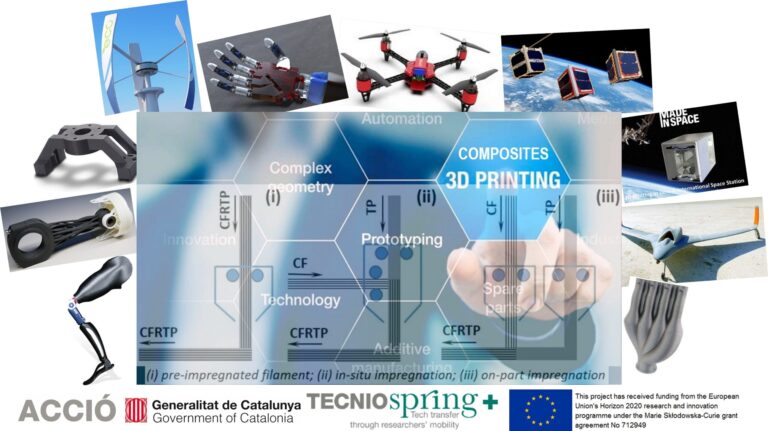Summary
A new Fused Filament Fabrication 3D Printing technology for continuous fiber reinforced high performance thermoplastic polymers (e.g., PEI, PES, PEEK, PEKK) is proposed. The novelty resides in the fact that pre-impregnated composite tapes available from the industrial Automatic Fiber Placement composite manufacturing process are used as feedstock (instead of pre-impregnated filaments as currently done by other market players).
Main use cases: lightweight and high thermo-mechanical performance (stiffness, strength, fracture toughness, temperature, humidity, radiation, chemical agents resistance) applications operating under severe loading and environmental conditions, for industries like aerospace, automotive, bio-mechanics (e.g., tools/tooling, functional prototypes, complex brackets, casings and paneling, hot engine parts, intricate duct bodies and connectors, cubesats, UAV/drone bodies, small scale wind turbine blades, robotic parts, sporting goods, prosthetic implants).
Result description
A new type of extrusion head to process the feedstock tapes in a FFF manner, and the afferent new composite 3D printing method. AFP tapes have standard thickness approx. 0.15 mm and widths 3.175/6.35/12.7 mm, which provide for output diameters of 0.78/1.1/1.35 mm. Stacked input tapes can be used if higher diameters are wanted or if different material systems are used for the input tapes to obtain a hybrid 3D printed material. The fact that the technology is not based on in-house proprietary feedstock from the same company that sells the 3D printer (as currently done by other market players),but rather on high-quality feedstock tapes which are freely available on the market from a large number of industry certified manufacturers and in a large variety of fiber/matrix combinations,creates the conditions for the 3D printer end user to have access to a larger variety of higher quality feedstock materials (democratization of the composite 3D printing feedstock).The feedstock affordability translates into the lower price of the final 3D printed composite parts.The feedstock high quality and thermo-mechanical performances translates into the same for the final 3D printed composite.
Addressing target audiences and expressing needs
- Business partners – SMEs, Entrepreneurs, Large Corporations
- I/we wish to transfer my/our IPR to an interested party
- Collaboration
- Funding for further RDI towards increasing the TRL.
- Technology development partners for further RDI and TT.
- Industry business partners for TT, commercialization, current and further IPR transfer.
- Other Actors who can help us fulfil our market potential
- Research and Technology Organisations
- Private Investors
R&D, Technology and Innovation aspects
Current stage – TRL3:
- Concept formulation.
- CAE design and virtual prototyping.
- PoC physical prototyping.
- EPO&PCT patent application.
Next steps:
- Current IPR valorization/licensing.
- Further RDI for TRL advancement and IPR generation (through competitive research calls and/or embarking on acceleration/incubation programs).
- Further IPR valorization/licensing.
The scalability potential of the business can be inferred from:
- Different target customers: 3D printing service providers, 3D printing technology end users (individuals, academic, research, industry), composite parts end users (e.g., industry OEM).
- Different products which can be commercialized: individual extrusion heads, 3D printers (desktop size, industry large size, robotic arm), 3D printed parts.
- Different industry applications/sectors (tools/tooling, aerospace, automotive, energy, sporting, medical).
- Different geographic markets.
Based on sound science, clear design models, and trials/testing of different feedstock material systems.
Result submitted to Horizon Results Platform by AGENCIA PER A LA COMPETITIVITAT DE LA EMPRESA

